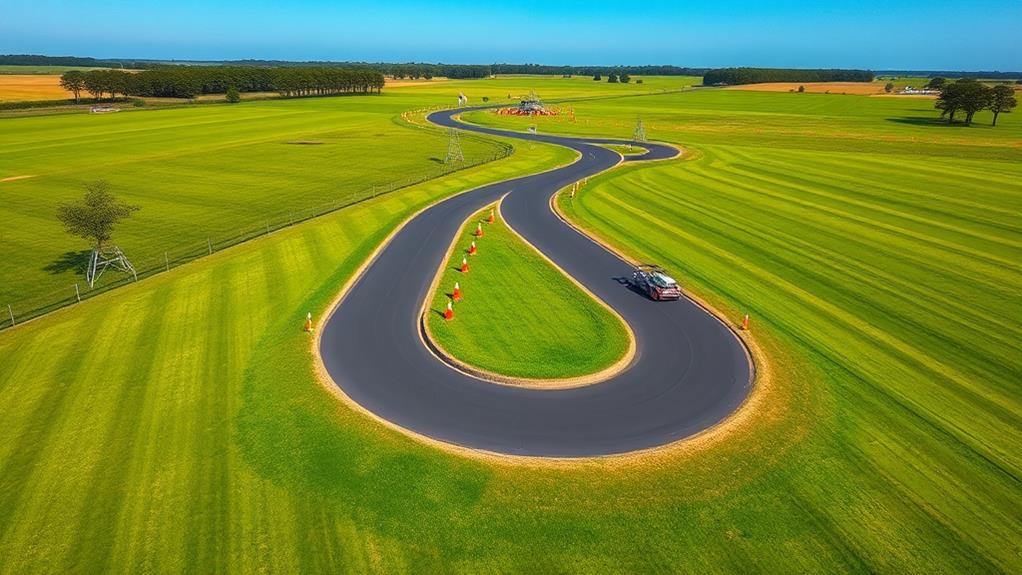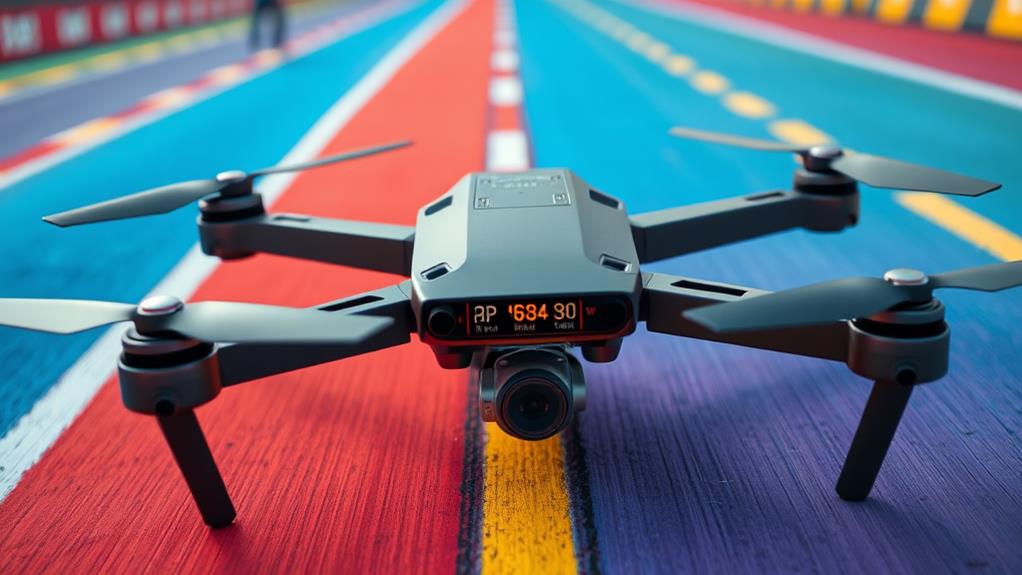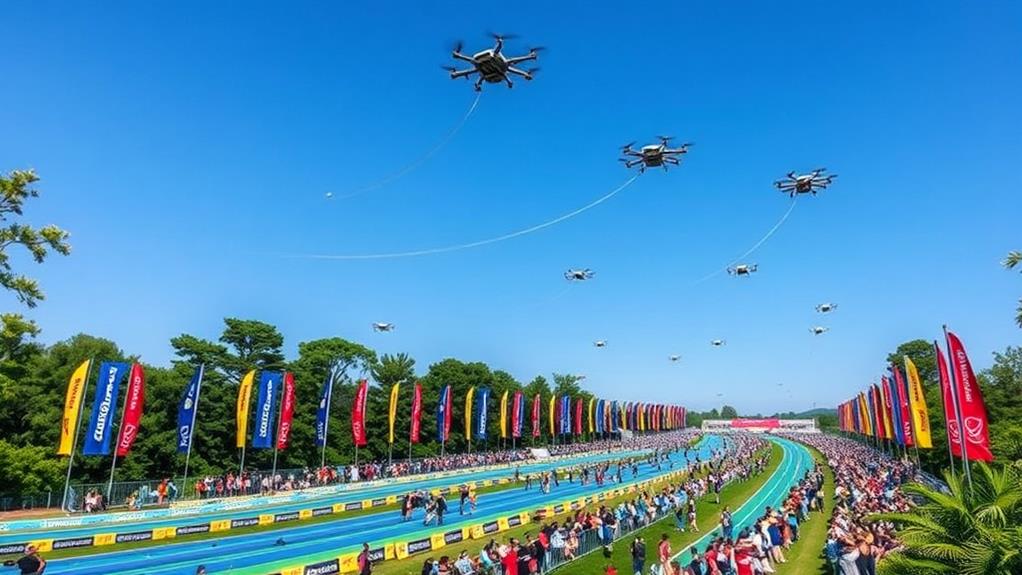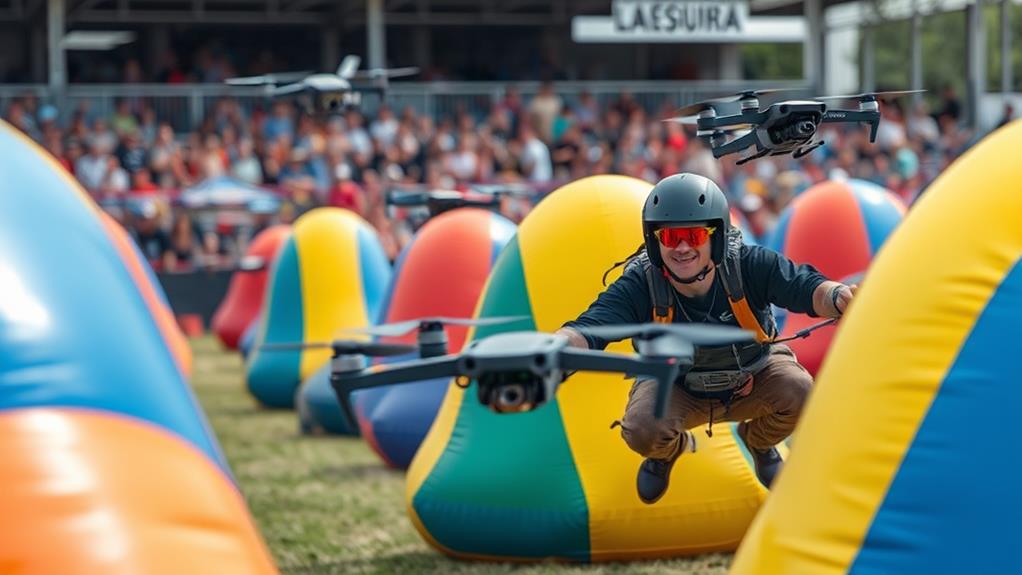Practicing key drone racing drills is essential for improving your skills and performance in competitive racing. These drills help build muscle memory, increase precision, and prepare you for real-world challenges. Engaging in agility courses boosts your control, while time trials enhance your speed and accuracy under pressure. Analyzing your performance through video reviews helps identify areas for improvement. Additionally, developing mental techniques, like visualization, bolsters your confidence. Networking with fellow pilots fosters a supportive learning environment. By understanding your equipment and utilizing simulators, you can hone your skills safely, ensuring you're ready for every race. There's much more to explore on this topic.
Benefits of Consistent Practice

When you commit to consistent practice, you'll find that it builds muscle memory, allowing you to execute maneuvers with precision and confidence during races. Regular practice sessions greatly enhance your drone racing skills, setting you apart from less committed pilots.
Studies show that those who practice consistently outperform their peers in competitive settings, demonstrating the tangible benefits of a structured routine.
Practicing under varied conditions helps you adapt to real-world challenges, which is essential when unexpected situations arise during races. By engaging in frequent practice, you're not just honing your skills; you're also fostering a growth mindset.
This mindset encourages you to continually refine your techniques, pushing you to achieve higher levels of success. Tracking your lap times and performance metrics can provide measurable evidence of your improvement, motivating you to keep pushing forward.
Within the racing community, consistent practice becomes a shared value, as pilots learn from one another and elevate their skills together. Embracing this journey won't only improve your skills but also deepen your connection with fellow racers, making the experience more enriching and rewarding.
Essential Drills for Skill Development
To elevate your drone racing skills, incorporating essential drills into your practice routine is important.
Start with slalom courses, which require you to quickly maneuver around tightly spaced obstacles. This drill enhances your agility and control, significant skills as a pilot.
Next, engage in time trials; they challenge you to improve your speed and accuracy under pressure, fostering resilience. Incorporating these exercises into your regular practice will boost your competitive spirit.
Obstacle courses are another key element. They enhance your spatial awareness and reaction times, forcing you to adapt to varying challenges and unexpected changes in your flight path.
Using a drone racing simulator can further refine these skills in a controlled environment, allowing you to practice flying without the risk of crashing your real drone.
Consistent practice of these drills leads to measurable skill gains, enabling you to track your progress effectively.
As you tackle these challenges, you'll see improvements in your overall performance, making you a more proficient racer.
Analyzing Performance Through Review

Performance analysis is a essential component of improving your drone racing skills. By reviewing flight recordings, you can pinpoint missed gates or improper turns, allowing for targeted corrections in your future practice sessions.
Analyzing performance through video footage highlights specific maneuvers that require enhancement, enabling you to adopt a focused approach to skill development. Setting specific goals based on your flight performance analysis leads to measurable progress and boosts your confidence in racing abilities.
For instance, if you notice a consistent issue with sharp turns, you can dedicate practice time to refining that particular skill. Feedback from peers during post-flight reviews also proves invaluable. Their insights can help you refine your techniques and strategies, making your practice sessions more effective.
Moreover, consistent performance analysis fosters a deeper understanding of your personal strengths and weaknesses. This knowledge is essential for continuous improvement in drone racing.
The Role of Mental Preparation
Mental preparation is essential in drone racing, as the sport challenges not only your skills but also your mind.
By using visualization techniques, you can mentally map out your race course, helping to reduce anxiety and boost your confidence.
Incorporating stress management strategies will further enhance your focus, allowing you to tackle race day with a clear, determined mindset.
Visualization Techniques
In drone racing, visualization techniques play an essential role in your preparation for competition. By engaging in mental rehearsal, you can mentally simulate racing scenarios, which greatly enhances your performance. This practice prepares your mind for actual conditions, helping to reduce performance anxiety.
When you visualize successful maneuvers and strategies, you create clear mental images that boost your focus and determination. Research shows that athletes who utilize visualization techniques often experience increased confidence and reduced anxiety during races.
This mental preparation reinforces muscle memory, making it easier for you to execute complex maneuvers when it counts. The more you visualize your flight paths and reactions to potential obstacles, the more instinctive your responses will become.
Incorporating mindfulness practices alongside your visualization efforts can further enhance your mental readiness. These practices help you maintain composure and concentration under pressure, ensuring you stay in the zone during critical moments of the race.
Stress Management Strategies
Building on the visualization techniques you've practiced, managing stress becomes equally important in drone racing. Effective stress management helps you maintain focus and perform at your best during high-pressure situations. Incorporating mental preparation strategies, like positive self-talk and grounding techniques, can greatly reduce anxiety before races. These methods allow you to calm your nerves and enhance your decision-making skills.
As you practice and learn, building confidence through consistent training is essential. Setting clear, achievable goals for each practice session not only keeps you focused but also alleviates feelings of being overwhelmed. This approach fosters better mental resilience, enabling you to tackle challenges more effectively.
Mindfulness practices also play an important role in stress management. By learning to manage your expectations and emotions, you can improve your overall performance consistency.
When you're centered and aware, you can channel your visualization skills into real-time racing scenarios, enhancing your ability to navigate courses successfully. Embracing these strategies won't only elevate your confidence but also contribute to a more enjoyable drone racing experience.
Prioritize these stress management techniques to become a more capable and composed pilot.
Community Support and Engagement

Supportive communities are essential for drone racing enthusiasts looking to enhance their skills and enjoy the sport. Engaging with fellow pilots—both locally and online—creates a nurturing environment that accelerates learning and sharpens individual skills. Organizations like MultiGP host frequent events where you can practice together, motivating one another in a competitive yet friendly atmosphere.
Celebrating small victories as a group boosts morale and encourages ongoing participation and improvement. Whether you're a novice or experienced pilot, networking through community channels offers valuable insights and mentorship that can greatly elevate your racing capabilities. Experienced pilots often share tips and tricks that can help you navigate challenges more effectively.
Participation in community-driven events is especially beneficial for newcomers, providing access to resources and guidance that make the shift into drone racing smoother and more enjoyable.
These communities foster a sense of belonging, making the sport not just about racing but also about camaraderie. By engaging with others who share your passion, you'll find that the learning curve becomes less intimidating, and the thrill of drone racing becomes even more rewarding.
Don't underestimate the power of community support as you pursue your racing goals!
Utilizing Technology and Simulators
Drone racing has evolved with technology, and using simulators is one of the best ways to enhance your skills. Simulators like EreaDrone 2023 offer unique features such as track editors and multiplayer modes, allowing you to practice various racing scenarios without risking damage to your equipment. This controlled environment is perfect for mastering basic maneuvers and improving your reaction times.
By incorporating simulators into your training routine, you can experience diverse racing scenarios that prepare you for real-world challenges. This adaptability is essential for enhancing your performance on race day. Regular practice in simulators can also bridge gaps in your training during the off-season, ensuring your skills remain sharp year-round.
Furthermore, the cost-effectiveness of simulators allows you to practice extensively without the financial burden of repairing crashes or replacing damaged drones. This means you can focus on improving your technique without worrying about the costs associated with physical practice.
Fundamentally, utilizing technology and simulators is an invaluable tool for any aspiring drone racer, providing a safe and efficient way to hone your skills and techniques in this thrilling sport.
Importance of Equipment Familiarity

To excel in drone racing, knowing your equipment inside and out is essential. Familiarity with your drone's components, like the motors, ESCs, and flight controller, can greatly enhance your reaction times and overall piloting performance.
When you regularly practice with identical quads, you develop a deeper understanding of their nuances, leading to more consistent racing results. This knowledge can be the difference between winning and losing.
Understanding your drone's setup—such as weight distribution and battery placement—improves handling and responsiveness on the track. It allows you to make quick adjustments that can impact your performance.
Additionally, knowing your drone's maintenance needs, like battery health and propeller condition, prevents mechanical failures during critical moments in a race.
Being well-acquainted with your remote controller settings, including rates and expo, enables you to quickly adapt to different racing conditions and personal flying styles.
This familiarity not only boosts your confidence but also allows you to focus on racing rather than troubleshooting. In drone racing, the more you know about your equipment, the better you'll perform, so invest the time to practice and build that essential familiarity.
Staying Updated on Regulations
Maneuvering the world of drone racing requires more than just skillful flying; you've got to stay on top of regulations that govern the sport. Understanding drone regulations is essential for every racer.
In the U.S., the FAA mandates that drone pilots comply with Part 107 regulations for commercial operations, which includes passing a knowledge test. It's important to know whether you need a pilot's license or if your drone needs to be registered.
Local laws can vary considerably, so you must be aware of specific rules regarding flying locations, times, and altitude limits. Many countries establish no-fly zones, particularly near airports and populated areas. Ignoring these regulations risks severe penalties, including fines and disqualification from competitive events.
To practice safely and responsibly, familiarize yourself with these laws before you take to the skies. Regularly checking for updates on local and national regulations will help guarantee compliance and keep you informed about any changes.
Conclusion
In drone racing, honing your skills through consistent practice isn't just beneficial; it's essential. By mastering key drills, analyzing your performance, and engaging with the community, you'll navigate the skies with confidence. Embrace technology and familiarize yourself with your equipment, ensuring you stay ahead of regulations. As you sharpen your abilities, remember that each flight is a stepping stone, propelling you toward mastery in this exhilarating sport. So gear up, practice hard, and watch yourself soar!

Leave a Reply